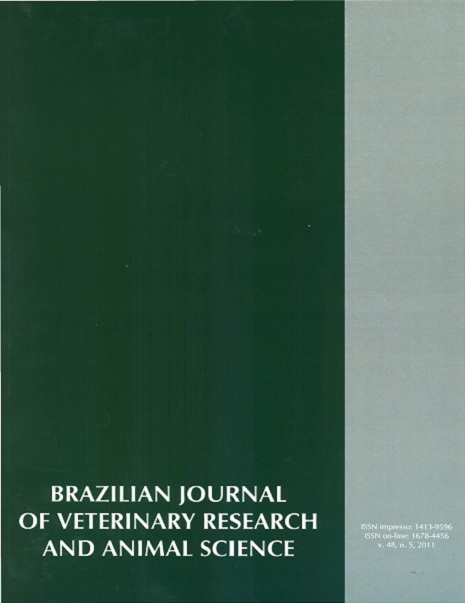Semen evaluation of captive male red-winged tinamous (Rhynchotus rufescens) supplemented with selenium
DOI:
https://doi.org/10.11606/S1413-95962011000500003Keywords:
Bird semen collection, Selenium, Red-winged tinamouAbstract
Due to the commercial importance of the red-winged tinamou (Rhynchotus rufescens), for the past few years, the employment of reproductive biotechnologies has been attempted. Thirty animals were randomly assigned into two groups: control group (no selenium) and treatment group (supplemented with 0,2 a 0,8 mg selenium/ 1000 kg ration). Animals were allocated at the FCAV - UNESP/Jaboticabal (2007-2008). Semen collections were performed by digital manipulation and divided in pools of at least 150 µL. After the immediate evaluation of motility, vigour, concentration and morphology, an aliquot of 20 µL was diluted in 300 µL of physiologic solution in order to test acrosome and membrane integrities, which were performed by counting 200 cells for each test. Cells were evaluated as follows: 1) Intact acrosome: lilac acrosome; Non-intact acrosome: pink acrosome; 2) Live cells: non stained; Dead: stained. Data was statistically analysed using the SAS System for Windows. No differences were found between treatment and control groups for volume, motility, vigour, mean number of spermatozoa per animal, concentration, Intact acrosome, Intact membrane. The difference found on midpiece sperm defect (Se = 1,33 ± 0,53 and control = 3,78 ± 0,69, p = 0.0107) may be due to the damages caused by the selenium deficiency to the architecture of the midpiece, which compromises sperm mobility and fertilization capacity.Downloads
Download data is not yet available.
Downloads
Published
2011-10-01
Issue
Section
UNDEFINIED
License
The journal content is authorized under the Creative Commons BY-NC-SA license (summary of the license: https://
How to Cite
1.
Góes PA de A, Cavalcante AK da S, Tavian AF, Felipe L, Santos EC, Nichi M, et al. Semen evaluation of captive male red-winged tinamous (Rhynchotus rufescens) supplemented with selenium. Braz. J. Vet. Res. Anim. Sci. [Internet]. 2011 Oct. 1 [cited 2026 Jan. 18];48(5):370-7. Available from: https://revistas.usp.br/bjvras/article/view/34402





